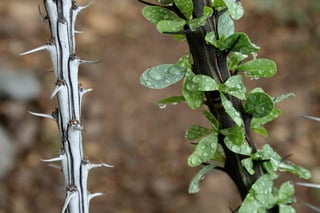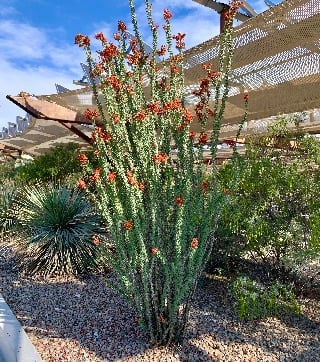Ocotillo is a stunning specimen plant that’s uniquely suited to survive harsh desert conditions. It’s a beautiful hummingbird magnet when in bloom, but its attractiveness changes with the weather. Here’s what you need to know to decide whether desert native would be a good choice for your yard and how to care for an existing one.

Ocotillo (Fouquieria splendens) is a spectacular accent plant native to three American southwest deserts. This unique plant is hard to categorize — I’ve heard it called a shrub, a succulent, and a semi-succulent. But whatever you call it, it has many attributes that make it a desirable landscape plant under the right circumstances.
When it leafs out, each cane is covered with small, bright green leaves. When it blooms in the spring, vivid orange-red flowers perch atop each branch, waving in the breeze, attracting bees and hummingbirds like a magnet.
Flowers last for a month or so and are followed by seeds that are enjoyed by seed-eating birds and small mammals. Ground squirrels have been known to climb up the thorny canes to eat the flowers and seeds.
Ocotillo is generally javelina and rabbit resistant, but I was shocked to learn that desert cottontails will eat it if they’re desperate enough!
It’s an extremely low-maintenance plant. It doesn’t need pruning and produces minimal litter. Once established, it needs little-to-no supplemental water.
But its substantial size, multitude of thorns, and leaflessness most of the year means it’s definitely not the right plant for every situation.
Why I Like This Plant
- Dramatic native specimen plant
- Add architectural interest all year
- Vivid flowers attract hummingbirds
- Extremely low maintenance
A Unique Desert Survivor
When it comes to being a desert survivor, ocotillo is in a class of its own. Like many desert plants, it is semi-deciduous, meaning it loses its leaves when facing drought or cold. But few plants take this survival mechanism to the extreme like ocotillo.
This unique plant leafs out in the spring and then loses those leaves when the weather gets dry. After a summer rain, it will leaf out again and then lose those leaves. It can go through this cycle four to five times during the summer, depending on the rainfall.
While this is an incredible survival tool for the plant, it means that the plant is leafless most of the year, resembling a large bundle of dead, thorny sticks. Plants often look so lifeless that it’s hard to tell whether they are dead or alive! (If the canes are still pliable and have some green when scratched, a plant is alive.)
New plants are slow to establish and it can take two years or more before they send out their first leaves and flowers, so be prepared to be patient.
Here’s a look at the two stages of ocotillo side by side — both leafless and after it has leafed out.

Other Things to Watch Out For
Ocotillo’s canes are covered with prominent spines. Keep that in mind for safety.
Mature plants can easily overwhelm a small urban or suburban yard. And since you shouldn’t prune ocotillo to control its size, it’s imperative that you plant this with the future in mind. Plant them where they encroach on sidewalks or patios, and they become a hazard.
Optimal Growing Conditions
If you’re thinking of adding an ocotillo to your garden, you need to find a suitable place that will keep your plant healthy and looking good… while minimizing maintenance for you.
Here are the key factors to keep in mind.
Temperature
Ocotillo should be grown in arid regions of USDA Hardiness Zones 8 – 10. It tolerates intense desert heat and is cold-hardy down to 10℉.
Sun Exposure
Ocotillo does not like shade. It needs full sun and is happy in the reflected heat off a hot wall.
Size and Growth Rate
Ocotillo is a slow-growing plant that gets big. It typically reaches a mature size of 15 to 20 feet tall by 10 feet wide.

Soil
In its native habitat, it grows in poor, sandy or rocky alkaline soil. It will even grow in soil with caliche. In the garden, it will grow in any native desert soil, provided it’s well-draining. Growing this plant in poorly drained soil can lead to root rot.
Other Location Considerations
Ocotillo should not be planted near foot traffic or anywhere people or pets might bump into its thorns.
Don’t plant ocotillo near other landscape plants that are frequently irrigated. Ocotillo roots can extend 20 feet and will rot if not allowed to completely dry out between waterings.
Don’t plant ocotillo close to plants that need routine maintenance. With all those thorns, you don’t want to be working around them. I lived in a house with a huge ocotillo that was downhill from large oak tree. Picking up hundreds (thousands?) of acorns that had rolled under the ocotillo’s canopy was a task I dreaded. 🫣
Ocotillo:
The Essentials
| Common Name | Ocotillo |
| Scientific Name | Fouquieria splendens |
| Origin | Sonoran, Chihuahuan, Mohave Deserts |
| Plant Type | Succulent, shrub |
| USDA Zones | Zones 8 – 10 |
| Cold Hardiness | To 10℉ |
| Flower Color | Orange-red |
| Flower Season | Spring |
| Mature Size | 15-20′ high x 10’ wide |
| Growth Rate | Slow |
| Sun Tolerance | Full, reflected sun |
| Water Needs | Low |
| Pests & Diseases | Root rot if overwatered |
| Cautions | Thorns |
| Wildlife | Attracts bees, hummingbirds Rabbit, javelina resistant |
Planting an Ocotillo
Before obtaining an ocotillo, you have an important decision to make…
Salvaged Plant or Seed-Grown?
First, you must decide whether you want a seed-grown plant or a bare-root salvaged plant.
Salvaged plants either come from construction sites or are collected in other states, sometimes illegally. These are sold as bare-root plants and have a 50% survival rate. At one time, this was the only way ocotillos were available.
If you buy a bare-root plant, get it from a reputable nursery where you are (hopefully) buying a freshly collected plant with legal tags and permits.
Now, you can find container plants that have either been grown from seeds or cuttings. A plant grown from seed will start out smaller than a bare-root ocotillo, but it will be easier to plant and much more likely to survive. Sometimes you find them at Spadefoot Nursery, Tucson’s top source for native plants.
While you can buy plants propagated from a cane cutting, I have it on good authority that they rarely branch and stay a stick.
How to Plant
When you’re ready to plant, dig a hole as deep and as wide as the root system. It’s generally recommended that you not add any amendments, just use the native soil you just dug up. However, good drainage is critical. If you know your soil is slow draining, amend with coarse sand or small gravel until you have a loose, well-drained mix.
Carefully put the root system in the hole, and press the soil to remove any air pockets. If possible, plant it in the same orientation it was at the nursery. Better nurseries should mark this for you.
Note that if you’re planting a bare-root plant, prune any damaged roots and allow it to dry for a week prior to planting.
When to Plant
Ocotillos can be planted any time of year by knowledgeable landscape professionals, but plants have the best chance of survival when planted March through May. Warm soil temperatures encourage their root development.
How to Care for Ocotillo
Whether you’ve recently planted an ocotillo or have an existing plant in your yard, here’s how to take care of it to keep it healthy and looking its best.
How to Water New Plants
Water a newly planted ocotillo once per week during the summer and once per month during the winter. You can skip a watering if there’s been rain. Don’t overwater — too much water is more likely to kill a plant than underwatering.
Interestingly, it’s recommended that you water a new bare-root plant by spraying the canes with a hose. Ocotillos can take up water this way!
How to Water Established Plants
Once your ocotillo routinely leafs out and flowers in the spring, you can consider it “established” and adjust its watering schedule. This usually takes 6 months to 2 years. Container plants establish faster.
Water it once or twice a month in the summer, if there’s been no rain. There’s no need to water ocotillo during the cooler months.
Plants survive in the wild just fine with no supplemental water, but your plant will look grow faster, leaf out and flower more, and generally look better with supplementarl water.
Should You Fertilize?
There is no need to fertilize ocotillo. This plant has evolved to get all the nutrients it needs from the surrounding desert soil.
How to Prune
Ocotillo does not need pruning. You should never trim it like a shrub or top off tall canes.
If you need to remove a cane, cut it back as close to the base as possible. By removing canes on the outer permieter of your plant, you can somewhat control its width.
Plant Lover Facts
Ocotillo means “little torch” in Spanish. It goes by other common names including coachwhip, Jacob’s staff, and vine cactus (it’s not a cactus).
It’s native to the Sonoran, Chihuahuan, and Mohave Deserts and can be found growing wild in Arizona, California, Nevada, New Mexico, Texas, and Mexico
It’s a slow-growing and extremely long-lived plant. Some of the largest specimens in the wild are over 200 years old!
Native Americans put this plant to good use. It was consumed for food and drink, and used medicinally. It was also used for firewood and as a building material.
We still use it today. The canes are sometimes used to build ramada roofs or as a living fence. If you’re considering using it as a fence, Civano Nursery has helpful FAQ information.
Did you enjoy this article?
Sign up for our weekly newsletter
where you’ll find more great info on creating &
maintaining a beautiful, carefree desert landscape.
Author Bio
Deane Alban is the creator of Southwest Gardener. She is a science writer with a bachelor’s degree in botany from the University of South Florida. Gardening is her lifelong passion. She’s been gardening in Tucson for 15 years.

